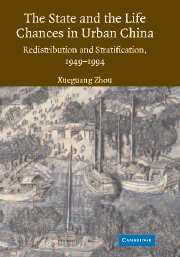Book contents
- Frontmatter
- Contents
- List of Figures
- List of Tables
- Preface
- Credit Line
- 1 Redistribution and Stratification Dynamics Under State Socialism
- 2 Overview: Historical Context and Research Design
- PART ONE REDISTRIBUTION AND STRATIFICATION DYNAMICS: EMPIRICAL EVIDENCE
- 3 Educational Stratification
- 4 Entry Into the Labor Force: Patterns of First-Job Attainment
- 5 Children of the Cultural Revolution: The Send-Down Episode
- 6 Climbing the Political Ladder: Bureaucratic Career Patterns
- PART TWO ASSESSING INSTITUTIONAL CHANGES IN THE POST-MAO ERA
- PART THREE SUMMARY AND CONCLUSION
- References
- Index
5 - Children of the Cultural Revolution: The Send-Down Episode
Published online by Cambridge University Press: 28 October 2009
- Frontmatter
- Contents
- List of Figures
- List of Tables
- Preface
- Credit Line
- 1 Redistribution and Stratification Dynamics Under State Socialism
- 2 Overview: Historical Context and Research Design
- PART ONE REDISTRIBUTION AND STRATIFICATION DYNAMICS: EMPIRICAL EVIDENCE
- 3 Educational Stratification
- 4 Entry Into the Labor Force: Patterns of First-Job Attainment
- 5 Children of the Cultural Revolution: The Send-Down Episode
- 6 Climbing the Political Ladder: Bureaucratic Career Patterns
- PART TWO ASSESSING INSTITUTIONAL CHANGES IN THE POST-MAO ERA
- PART THREE SUMMARY AND CONCLUSION
- References
- Index
Summary
It is necessary for the educated youth to go to the countryside, and be reeducated by the poor peasants. We need to persuade cadres and others in urban areas to send their children who graduated from middle school, high school and college to rural areas. Let us have a mobilization. Comrades in rural areas should welcome them.
Mao Zedong, 1968In retrospect, 1968 can be labeled as “the year of student movements.” In that year, college students in Paris took to the streets to protest the deterioration of the educational system in France; student protests broke out at UC Berkeley and other campuses in the United States against the U.S. government's involvement in the Vietnam War. In that same year, however, high school and college students in China were in turmoil. Only two years before, the “Red Guard Rebellion” on college campuses and in secondary schools swept the nation, drew worldwide attention, and initiated the momentum of the Cultural Revolution. Under attacks from the Red Guards, government administrations and educational institutions were paralyzed: Government offices were taken over by the Red Guards, and no classes were offered in schools (Pepper 1996; Unger 1982). By 1968, the cold reality set in: Students could not graduate from school or advance to the next educational level; nor could they be assigned to a job in urban areas. More than six million secondary school students accumulated in schools, waiting to graduate and to be assigned a job by the government (Shi 1996).
- Type
- Chapter
- Information
- The State and Life Chances in Urban ChinaRedistribution and Stratification, 1949–1994, pp. 124 - 153Publisher: Cambridge University PressPrint publication year: 2004
- 2
- Cited by



